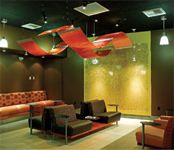Arizona hospital puts clients first
Ross Lirtzman, DVM, Dipl. ACVS, wanted to make a statement with his new specialty practice in Scottsdale, Ariz. Everything was taken into account to make clients and patients feel relaxed, much like in a modern human doctor's office or hospital.
Scottsdale, Ariz. — As owner of a specialty referral practice, Ross Lirtzman, DVM, Dipl. ACVS, realizes his team starts with a handicap: They have to gain client trust while working with very sick animals.

State of the art: Care and comfort come first at this Arizona specialty practice.
Communication is critical, but so is creating a level of comfort and calm. And all of these considerations were built into his newly designed Animal Specialty Group of Scottsdale.
Lirtzman moved from Southern California, where he had a part of a large, multi-speciality practice, to Phoenix for three years before settling in Scottsdale, which had no surgery specialty practices. Lirtzman, seeing the continuing shift in how people care for their pets, wanted to make a statement with his new practice.
"I didn't want it to look like a typical veterinary practice," he says. "I wanted something comfortable, a place people could come and feel at ease. When clients are referred to us, it's because they have big problems, serious problems."
Everything — from furniture, to layout, to lighting, to climate control — was taken into account to make clients and patients feel relaxed.
The exam rooms are large by design, with ample seating that includes small sofas.
"It's not unusual for us to see an entire family come in with the family dog," Lirtzman says. "The average consult is an hour. In order to keep someone here that long, it really needs to be comfortable."
Operating rooms were designed to resemble what one might find in a human hospital. The rooms are larger and HEPA-filtered air is pumped in.
"The air is especially important in a desert climate," Lirtzman notes. "On a day like today, it's 115 degrees out here in Scottsdale. We need to be comfortable as surgeons. We need to control the air for bacteria. What we want clients to know and appreciate is that we take care of their pets."
The floors are seamless with baseboard suction systems to remove dirt and other particles. Additionally, the facility is energy-efficient, with special attention to lighting and window treatments.
The 6,000-square-foot facility, which opened in April, specializes in surgery, oncology and dermatology. Four specialists, two surgeons, one oncologist, one dermatologist and about 15 other team members make up the staff.
Great care also went into creating a safe work environment for the staff, Lirtzman says.
For example, anesthetic acids are removed from the operating-room environment, keeping harmful toxins out of the air.
More than anything, Lirtzman believes in client communication from admittance to check out, even allowing owners to view live surgery of their pet via the Web.
While it has become a growing trend for boarding facilities to set up Web cams for pet owners, Lirtzman has taken the concept one step further.
"Quite frequently, people want to see what we're doing," he notes. "It poses a lot of problems for us as surgeons to have pet owners viewing surgeries directly."
The solution was allowing owners to view remotely by assigning usernames and passwords.
So far, it has been a "huge success," Lirtzman says.
While clients generally can see what the surgeon is doing, the camera isn't right on top of the surgeon. Owners can see that the animal is OK and that the surgery is proceeding, but there aren't close-up views.
Additionally, owners can call in during surgery to receive updates or the hospital's team will call with status reports.
For those who prefer to remain on-site during surgery, family waiting rooms resembling living rooms were created to give them a quiet place to wait and pass the time.
"It's a business about taking care of people who own pets," Lirtzman adds.